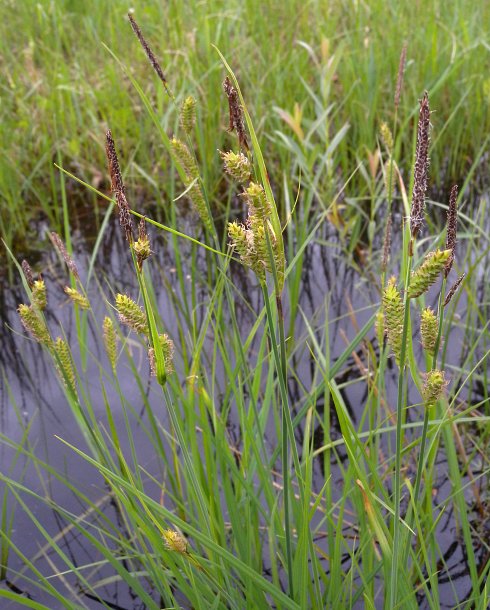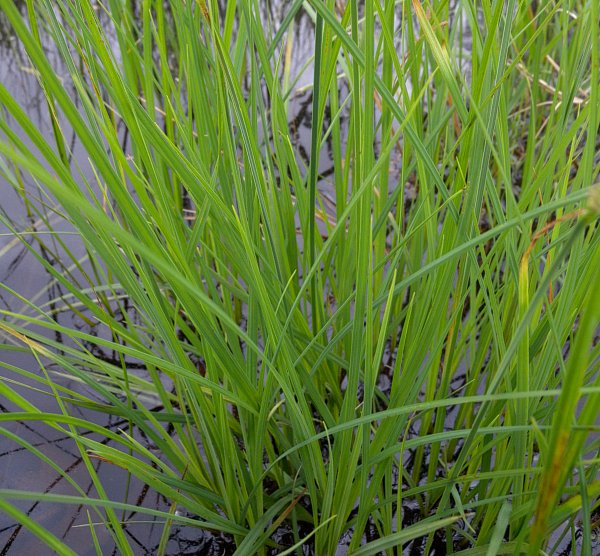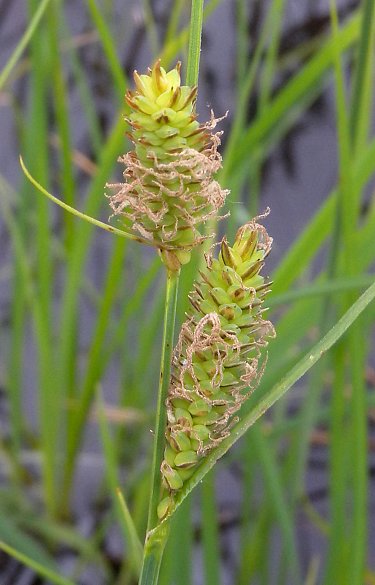
The blooming period occurs during late spring for about 1-2 weeks. The florets are cross-pollinated by the wind. The mature achenes are about 0.5–1.0 mm. long, flattened-obovate in shape, rounded above, and obtusely tapered below. The root system is fibrous and rhizomatous.
Cultivation: The preference is full sun, wet to moist conditions, and sandy soil. Standing water is readily tolerated if it is seasonal or temporary.
Range & Habitat: The native Hayden's Sedge is occasional in NE Illinois, while in the rest of the state it is rare or absent (see Distribution Map). There is some evidence that its abundance has been declining as a result of drainage activities and various kinds of development (eFloras, www.efloras.org; access date 5-21-15). This sedge has been found in a variety of sunny wetland habitats, including wet sand prairies, sedge meadows, grassy bogs, grassy fens, sandy floodplains of rivers, edges of sandy marshes, and sandy ditches along grassy paths in natural areas. Hayden's Sedge is found in higher quality wetland habitats.

Faunal Associations: Many insects feed on the foliage, seeds, and other parts of wetland sedges (Carex spp.). These species include leaf beetles (Plateumaris spp.), billbugs (Sphenophorus spp.), larvae of leaf-miner flies (Cerodontha spp.), larvae of a rust fly (Loxocera varipes), seed bugs (Cymus angustatus, Oedancala dorsalis), plant bugs (Mimoceps insignis, Teratocoris discolor), a stink bug (Eurygaster alternata), Allaphis daviaulti and other aphids, sedge grasshoppers (Stethophyma spp.), larvae of sawflies (Pachynematus corniger, Paracharactus niger), larvae of skippers (Euphyes spp., Poanes spp.), larvae of such moths as Ctenucha virginica (Virginia Ctenucha) and Hypocoena inquinata (Tufted Sedge Moth), and larvae of a butterfly, Satyrodes eurydice (Eyed Brown); see Clark et al. (2004), Vaurie (1983), Majka et al. (2007), Spencer & Steyskal (1986), Marshall (2006), Hoffman (1996), Knight (1941), Lattin (1964), Blackman & Eastop (2013), Capinera et al. (2004), Smith (2006), Bouseman et al. (2006), and Panzer (2006). Among vertebrate animals, the seeds and spikelets of wetland sedges are eaten by ducks, rails, and other birds (see the Bird Table). Wetlands with sedges also provide important summer or migratory habitat for many birds. Muskrats eat the culms, roots, and sprouts of wetland sedges, while White-tailed Deer and Elk browse on the foliage sparingly. There is some evidence that White-tailed Deer spread the seeds of sedges in their droppings (Myers et al., 2004).

Photographic Location: A sandy ditch along a grassy path at the Iroquois County Conservation Area in Illinois.
Comments: This is an attractive wetland sedge with erect culms and brownish to reddish green spikelets. While Hayden's Sedge (Carex haydenii) is often compared to Tussock Sedge (Carex stricta) and other species in the Tussock Sedge group, it is actually quite distinct. Hayden's Sedge is smaller in size and the scales of its pistillate spikelets are longer than the perigynia. In contrast, Tussock Sedge and other species in its group are usually much larger in size and the scales of their pistillate spikelets are the same length or shorter than the perigynia. In addition, the tips of the pistillate scales for Hayden's Sedge are usually more acute than those of Tussock Sedge and other species in its group, and Hayden's Sedge usually has fewer staminate and pistillate spikelets in its inflorescence.